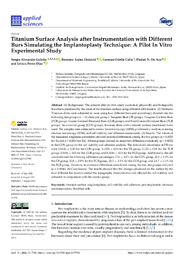Título :
Titanium Surface Analysis after Instrumentation with Different
Burs Simulating the Implantoplasty Technique: A Pilot In Vitro
Experimental Study |
Autor :
Gehrke, Sergio 
Dedavid, Berenice Anina 
Odella Colla, Germán
De Aza, Piedad 
Pérez-Díaz, Leticia  |
Fecha de publicación:
2022-08 |
URI :
https://hdl.handle.net/11000/28626 |
Resumen :
Background: The present pilot in vitro study evaluated, physically and biologically,
the effects produced by the wear of the titanium surface using different drill models. (2) Methods:
Titanium disks were subjected to wear using four different burs and accordingly divided into the
following test groups (n = 12 disks per group): Tungsten Burs (TB group), Tungsten Carbide Burs
(TCB group), Coarse-Grained Diamond Burs (CGB group), and Fine-Grained Diamond Burs (FGB
group). As a control group (CON group), titanium disks with a smooth surface (machined) were
used. The samples were subjected to atomic force microscopy (AFM), profilometry analysis, scanning
electron microscopy (SEM), and cell viability and adhesion assessments. (3) Results: The values of
the measured roughness parameters showed statistical differences among the five groups (p = 0.0035
for Ra and p = 0.0010 for Rz). All test groups showed an important difference statistically (p = 0.0032)
to the CON group for the cell viability and adhesion analysis. The data of cell absorbance at 570 nm
were 0.4122 0.05 for the CON group, 0.1354 0.02 for the TB group, 0.123 0.01 for the TCB
group, 0.1414 0.02 for the CGB group, and 0.1216 0.03 for the FGB group. Additionally, the cell
count showed the following adherence percentages: 57.6 4.6% for the CON group, 22.9 3.3% for
the TB group, 23.4 2.9% for the TCB group, 22.5 3.1% for the CGB group, and 23.7 3.3% for
the FGB group. However, no statistical differences were found among the four test groups analyzed
(p = 0.3916). (4) Conclusions: The results showed that the changes produced on the surface by the
four different bur models altered the topography characteristics and affected the cell viability and
adhesion in comparison with the control group
|
Palabras clave/Materias:
titanium surface; implantoplasty; cell viability and adhesion; peri-implantitis; titanium instrumentation; fibroblast cells
implantoplasty
cell viability and adhesion
peri-implantitis
titanium instrumentation
fibroblast cells |
Área de conocimiento :
CDU: Ciencias aplicadas: Ingeniería. Tecnología |
Tipo de documento :
info:eu-repo/semantics/article |
Derechos de acceso:
info:eu-repo/semantics/openAccess
Attribution-NonCommercial-NoDerivatives 4.0 Internacional |
DOI :
https://doi.org/10.3390/app12157920 |
Publicado en:
Applied Sciences; v. 12 , nº 15 |
Aparece en las colecciones:
Instituto de Bioingeniería
|
 La licencia se describe como: Atribución-NonComercial-NoDerivada 4.0 Internacional.
La licencia se describe como: Atribución-NonComercial-NoDerivada 4.0 Internacional.
.png)
